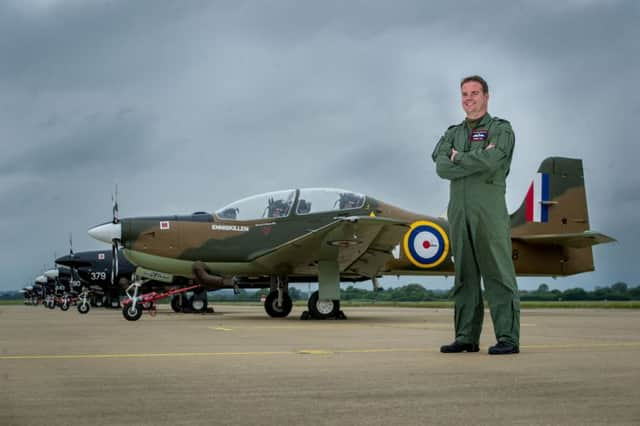An unchanged landscape as a '˜Spitfire' flies again over Yorkshire


But this was different. A modern Tucano training aircraft had been decorated in 1940s livery to mark the centenary of a squadron that had spent the war flying them and whose officers now train the fast jet pilots of the future.
Yesterday, it led a formation of four Tucanos on a grand flypast of some of the squadron’s wartime bases. It would have been more, but for the British summer.
Advertisement
Hide AdAdvertisement
Hide AdThe North Yorkshire landscape in which it touched down at 4.10pm had hardly changed in the decades since schoolboys clamoured to catch a thrilling glimpse of a Spitfire overhead. The locals in Linton-on-Ouse didn’t like it when the RAF moved in, in the mid-1930s, complaining to The Yorkshire Post that good agricultural land was being lost. They didn’t stay angry for long.
RAF No 72 Squadron had been formed in July 1917, operating SPAD VII biplanes of the Royal Flying Corps. Its crews were dispatched to Mesopotamia, then to France and across the Med. It was disbanded between the wars but reformed in 1937 as a fighter squadron and flew Spitfires for the duration.
A Tucano is of a similar size to a Spitfire, and, given the livery of this one, easy to mistake from the ground. “It certainly evokes images of a different England,” noted one of the ground crew as it approached.
Its markings resemble exactly the one on a painting on the wall at Linton-on-Ouse. Its registration reads RN-S Enniskillen, in recognition of the Ulster town whose locals who funded it. Beneath the cockpit are the names of two squadron members, Sqdn Leader Des Sheen DFC, and Leading Aircraftman Jim Barton. Sheen served during the Battle of Britain and Barton was an engine fitter. They never met during the war but Barton founded the 72 Squadron Association and Sheen became its first president.
Advertisement
Hide AdAdvertisement
Hide AdWing Commander Robbie Lees admitted he felt the weight of history on his shoulder as he brought the craft in yesterday. “It is quite humbling,” he said. “I was the first person to fly it because it needed to be air tested, and it was rather special.
“The other pilots in the formation had a spectacular view of it from the air.”
They saw less than they would have liked. With no radar on board, Tucano pilots need to maintain visual contact with the ground, said one of the instructors, Flt Lt Dave Kirby.
Yesterday’s low cloud meant that wasn’t possible, and so the ceremonial part of a planned grand flypast over North Yorkshire didn’t happen.
Advertisement
Hide AdAdvertisement
Hide AdThey had started the day over Cornwall, then headed for Upavon in Wiltshire, which had been the squadron’s original base in 1917. The last minute changes meant that a second crew spent the day in coaches on the A1.